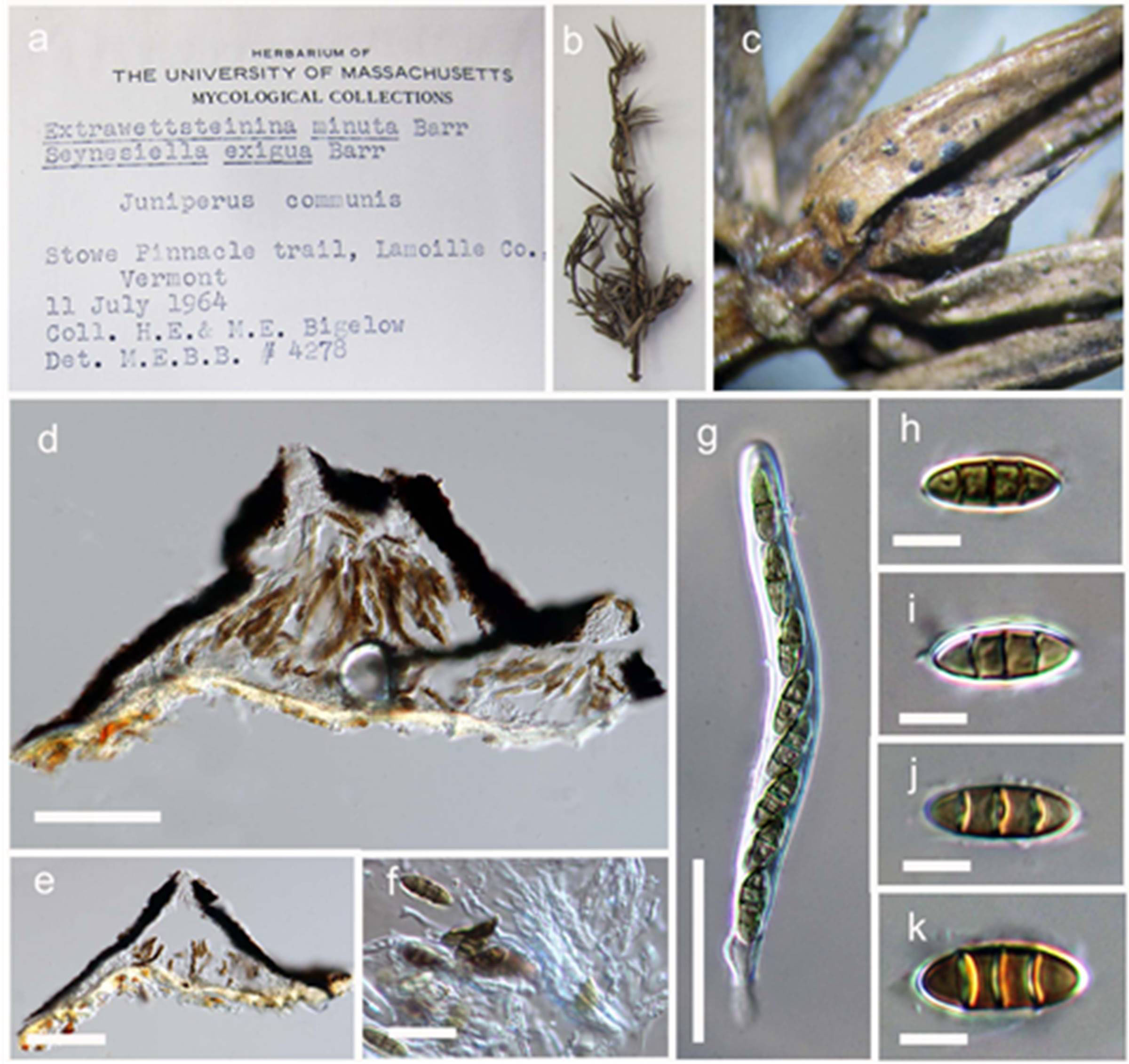Extrawettsteinina minuta M.E. Barr, Contr. Univ. Mich. Herb. 9(8): 538 (1972).
≡ Kriegeriella minuta (M.E. Barr) Arx & E. Müll., Stud. Mycol. 9: 88 (1975)
Saprobic on dead leaves of Juniperus communis. Sexual morph: Ascomata 100–150 × 210–350 µm ( = 120 × 280 µm, n = 10), scattered, erumpent to superficial, globose or conical, dark brown to black, carbonaceous. Papilla black, with a pore-like ostioles, ostiolar canal filled with periphyses. Peridium 10–25 µm ( = 21 µm, n = 10), a single layer composed of compressed, thick-walled cells, fusing with the host at the outside. Hamathecium of dense 1–1.5 µm ( = 1.25 µm, n = 20), broad, cellular pseudoparaphyses. Asci 75–90 × 6–8 µm ( = 80 × 7 µm, n = 10), 8-spored, bitunicate, fissitunicate, cylindrical, apex rounded with and a minute ocular chamber with short pedicel. Ascospores 10–12 × 4–5 µm ( = 11.5 × 4 µm, n = 10), uniseriate, slightly overlapping, ellipsoid, obovate-clavate, 3-septate, slightly to not constricted at the septum, with smooth wall. Asexual morph: not observed.
Material examined: USA, Vermont, Stow Pinnacle trail, on dead leaves of Juniperus communis L (Cupressaceae), 11 July 1964, H.E and M.E Bigelow (NY, 4278).
Notes: During our study we observed the holotype of Extrawettsteinina minuta (NY, 01103003) collected by H. E. Bigelow (19 August 1957) from Juniperus communis but we could not find any ascomata in the type material. Therefore we examine another collection of E. minuta (NY, 4278), which was collected from same host and by the same collector as present in Fig 15.
Extrawettsteinina was introduced by Barr (1972) and typified with E. minuta. The genus was introduced to accommodate three species, i.e. E. minuta, E. pinastri M.E. Barr and E. mediterranea (E. Müll.) M.E. Barr which are saprobic on the dead leaves of gymnosperms and angiosperms, in North America and Europe (Barr 1972). Subsequently, a fourth species was introduced, viz. E. andromedae (Auersw.) M.E. Barr (based on Wettsteinina andromedae), (Barr 1987a). Extrawettsteinina is characterized by superficial, conical ascomata, containing a few saccate bitunicate asci, ellipsoidal, obovate-clavate, septate, smooth and hyaline ascospores which turn dull brown at maturity (Barr 1972). The diagnostic character of Extrawettsteinina is its conic ascomata which are superficial on the substrate, and radiating arrangement of wall cells, which makes it distinguishable from comparable genera such as Stomatogene and Wettsteinina. Morphologically, Extrawettsteinina is comparable with Kriegeriella. In particularly, E. pinastri could not be distinguished from K. transiens or K. mirabilis. Thus, K. transiens, including Extrawettsteinina pinastri, was treated as synonyms of K. mirabilis, and was included in the section of Kriegeriella (von Arx and Müller 1975; Barr 1975). The other section of Kriegeriella, Extrawettsteinina, includes two previous Kriegeriella species, i.e. K. minuta and K. mediterranea. Barr (1987b) introduced a family, Kriegeriellaceae (Dothideales) to accommodate Kriegeriella and Extrawettsteinina. This proposal has rarely been followed.
Extrawettsteinina and Navicella share similarities, in having superficial globose or conical ascomata with long, trabeculate pseudoparaphyses embedded in a gelatinous matrix and brown ascospores but differ in the nature of ascomata (carbonaceous versus coriaceous), shape of asci (cylindrical with short pedicellate versus clavate to sub-cylindrical with long pedicellate) and the shape of the ascospores (ellipsoid, obovate-clavate versus ellipsoidal) and the nature of the ascospores (smooth spore wall without appendages versus verrucose spore wall with hyaline appendage). Recently Navicella was transferred to Melanommataceae by Ariyawansa et al. (2014e) based on its similarities with Melanommataceae. Extrawettsteinina is also compatible with Melanommataceae in having superficial globose to subglobose ascomata with long, trabeculate pseudoparaphyses embedded in a gelatinous matrix and brown ascospores but this needs to be confirmed by molecular data. In this study we tentatively refer Extrawettsteinina in Pleosporaceae following Zhang et al. (2012) and Lumbsch and Huhndorf (2010). Currently no molecular data is available for this genus therefore generic type needs to be collected, isolated and sequenced to show the natural classification of this genus.
Fig 1 Extrawettsteinina minuta (NY, 4278). a-b. Herbarium material. c. Fruiting bodies on the host. d-e. Sections of ascomata. f. Trabeculate pseudoparaphyses. g. Ascus with short pedicel. h-k. ellipsoid, obovate-clavate, 3-septate ascospores.. Scale bars: d = 80 µm, e = 50 µm, f = 10 µm, g = 30 µm, h-k = 5 µm.

